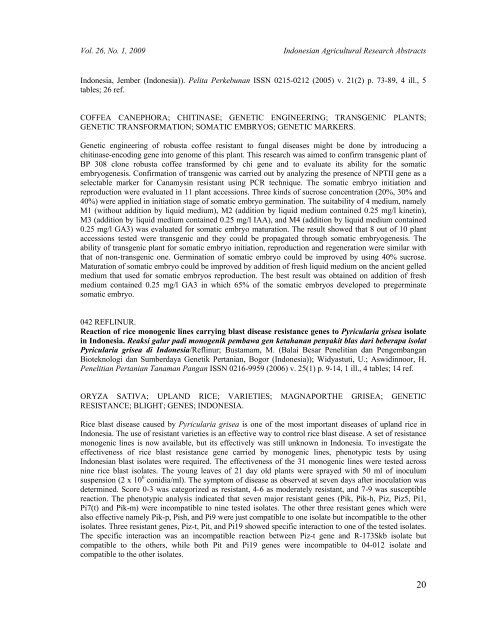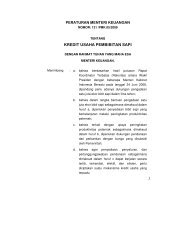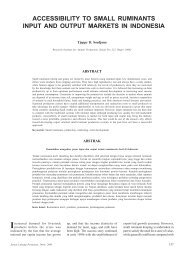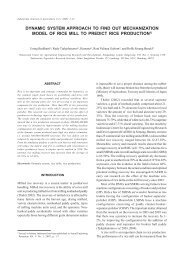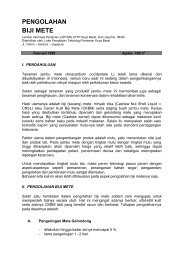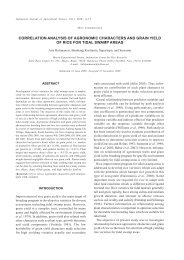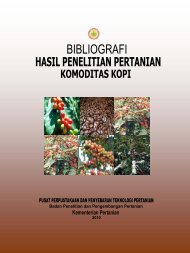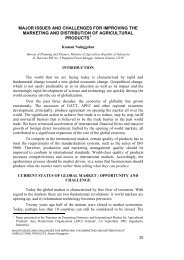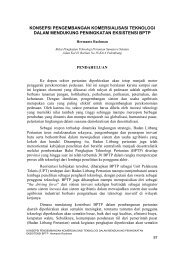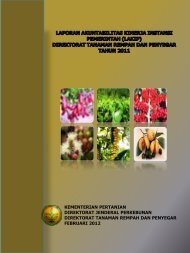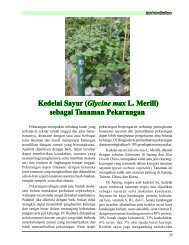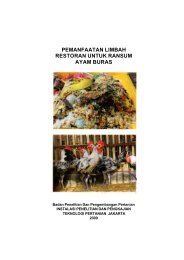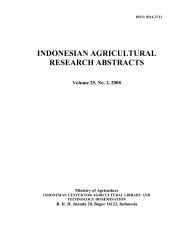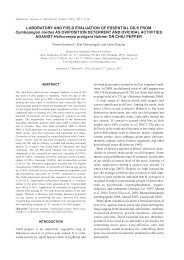Indonesian Agricultural Research Abstracts <strong>Vol</strong>. 26, <strong>No</strong>. 1, <strong>2009</strong>seeds of F2 population planted based on bulk method, and then their 1-2 dried pods bulked as next seedson F3 population. The second planting, 1200 seeds of F2, F3 and MLG 15151 populations planted andthen their 1-2 dried pods bulked as next seeds. The third planting the seeds of F3, F4, and MLG 15151populations planted and then their 1-2 dried pods bulked as seeds on next research. The natural selectionwas executed on all of planting and some of plants did not produce any pod. The number and weight ofpod per plant had high heritability on F2, F3 and F4 populations. Both of them would be fit ones asselection characters on the next population. Number of pod and seed, pod length, fresh weight of one podand weight of pod per plant, increased on F3 and F4 population. Selection from them would obtain higherfresh pod yield.039 KUSWANTO.[Selection of yardlong bean (Vigna sesquipedalis L. Fruwirth) promising lines]. Seleksi galur-galurharapan kacang panjang (Vigna sesquipedalis L. Fruwirth) Unibraw/Kuswanto; Soetopo, L.;Hadiastono, T. (Universitas Brawijaya, Malang (Indonesia). Fakultas Pertanian); Kasno, A. Habitat ISSN0853-5167 (2005) v. 16(4) p. 258-269, 2 tables; 16 ref. AppendixVIGNA UNGUICULATA SESQUIPEDALIS; PROGENY; SELECTION; GENOTYPES;ADAPTATION; RESISTANCE TO INJURIOUS FACTORS; YIELD COMPONENTS.The research was carried out to evaluate yield potential and resistance to CABMV, and also to select theUnibraw promising lines. The selected lines will be evaluated on adaptation test. The experiments wasconducted at Research Station of Brawijaya University, Jatikerto, Kromengan, Malang during <strong>No</strong>vember2004 to March 2005. The materials were 177 promising lines and 4 parent genotypes. The promising lineshad genetic variation on yield potential and the other variables, so they were selected. Eighteen lineswhich have high yield potential and resistant to CABMV were obtained, i.e. Unibraw 34039, Unibraw34061, Unibraw 34042, Unibraw 34053, Unibraw 24068, Unibraw 24034, Unibraw 34041, Unibraw14008, Unibraw 24035, Unibraw 24017, Unibraw 24089, Unibraw 24071, Unibraw 24088, Unibraw14023, Unibraw 24062, Unibraw 24191, Unibraw 24041 and Unibraw 14017.040 PARJANTO.Chromosome analysis for sex determination on salak (Salacca zalacca [Gaertner) Voss). Analisiskromosom untuk penentuan kelamin tanaman salak (Salacca zalacca [Gaertner] Voss)/Parjanto(Universitas Sebelas Maret Surakarta (Indonesia). Fakultas Pertanian); Artama, W.T.; Sukarti-Muljopawiro. Agrivita ISSN 0126-0537 (2006) v. 28(1) p. 35-44, 2 ill., 4 tables; 13 ref.SALACCA; CHROMOSOMES; FEMALES; MALES; SEX DETERMINATION.Chromosome variation analysis of male, female, and hermaphrodite of salak (Salacca zalacca) have beendone by squash-aceto orcein method for identifying the cytological sex marker and sex chromosome. Theresults showed that the number, length, and shape of chromosome in the male, female, and hermaphroditeplants were not different. They had the same karyotype structure, that is 2n = 28 = 11 m + 1 m (SAT) + 2sm (consisted of 11 pairs of metacentric chromosomes, 1 pair of metacentric chromosome bearingsatellite, and 2 pairs of submetacentric chromosomes). Sex of salak (S. zalacca) could not be identifiedbased on the observation of chromosome morphology. The morphological heteromorphic sexchromosomes were not appeared.041 PRIYONO.Confirmation of transgenic robusta coffee (Coffea canephora) transformed by chitinase-encodinggene and its propagation through somatic embryogenesis. Konfirmasi kopi robusta (Coffeacanephora) transgenik hasil transformasi dengan gen chitinase dan perbanyakannya melaluiembriogenesis somatik/Priyono; Budiani, A.; Mawardi, S.; Siswanto (Pusat Penelitian Kopi dan Kakao19
<strong>Vol</strong>. 26, <strong>No</strong>. 1, <strong>2009</strong>Indonesian Agricultural Research AbstractsIndonesia, Jember (Indonesia)). Pelita Perkebunan ISSN 0215-0212 (2005) v. 21(2) p. 73-89, 4 ill., 5tables; 26 ref.COFFEA CANEPHORA; CHITINASE; GENETIC ENGINEERING; TRANSGENIC PLANTS;GENETIC TRANSFORMATION; SOMATIC EMBRYOS; GENETIC MARKERS.Genetic engineering of robusta coffee resistant to fungal diseases might be done by introducing achitinase-encoding gene into genome of this plant. This research was aimed to confirm transgenic plant ofBP 308 clone robusta coffee transformed by chi gene and to evaluate its ability for the somaticembryogenesis. Confirmation of transgenic was carried out by analyzing the presence of NPTII gene as aselectable marker for Canamysin resistant using PCR technique. The somatic embryo initiation andreproduction were evaluated in 11 plant accessions. Three kinds of sucrose concentration (20%, 30% and40%) were applied in initiation stage of somatic embryo germination. The suitability of 4 medium, namelyM1 (without addition by liquid medium), M2 (addition by liquid medium contained 0.25 mg/l kinetin),M3 (addition by liquid medium contained 0.25 mg/l IAA), and M4 (addition by liquid medium contained0.25 mg/l GA3) was evaluated for somatic embryo maturation. The result showed that 8 out of 10 plantaccessions tested were transgenic and they could be propagated through somatic embryogenesis. Theability of transgenic plant for somatic embryo initiation, reproduction and regeneration were similar withthat of non-transgenic one. Germination of somatic embryo could be improved by using 40% sucrose.Maturation of somatic embryo could be improved by addition of fresh liquid medium on the ancient gelledmedium that used for somatic embryos reproduction. The best result was obtained on addition of freshmedium contained 0.25 mg/l GA3 in which 65% of the somatic embryos developed to pregerminatesomatic embryo.042 REFLINUR.Reaction of rice monogenic lines carrying blast disease resistance genes to Pyricularia grisea isolatein Indonesia. Reaksi galur padi monogenik pembawa gen ketahanan penyakit blas dari beberapa isolatPyricularia grisea di Indonesia/Reflinur; Bustamam, M. (Balai Besar Penelitian dan PengembanganBioteknologi dan Sumberdaya Genetik Pertanian, Bogor (Indonesia)); Widyastuti, U.; Aswidinnoor, H.Penelitian Pertanian Tanaman Pangan ISSN 0216-9959 (2006) v. 25(1) p. 9-14, 1 ill., 4 tables; 14 ref.ORYZA SATIVA; UPLAND RICE; VARIETIES; MAGNAPORTHE GRISEA; GENETICRESISTANCE; BLIGHT; GENES; INDONESIA.Rice blast disease caused by Pyricularia grisea is one of the most important diseases of upland rice inIndonesia. The use of resistant varieties is an effective way to control rice blast disease. A set of resistancemonogenic lines is now available, but its effectively was still unknown in Indonesia. To investigate theeffectiveness of rice blast resistance gene carried by monogenic lines, phenotypic tests by usingIndonesian blast isolates were required. The effectiveness of the 31 monogenic lines were tested acrossnine rice blast isolates. The young leaves of 21 day old plants were sprayed with 50 ml of inoculumsuspension (2 x 10 6 conidia/ml). The symptom of disease as observed at seven days after inoculation wasdetermined. Score 0-3 was categorized as resistant, 4-6 as moderately resistant, and 7-9 was susceptiblereaction. The phenotypic analysis indicated that seven major resistant genes (Pik, Pik-h, Piz, Piz5, Pi1,Pi7(t) and Pik-m) were incompatible to nine tested isolates. The other three resistant genes which werealso effective namely Pik-p, Pish, and Pi9 were just compatible to one isolate but incompatible to the otherisolates. Three resistant genes, Piz-t, Pit, and Pi19 showed specific interaction to one of the tested isolates.The specific interaction was an incompatible reaction between Piz-t gene and R-173S<strong>kb</strong> isolate butcompatible to the others, while both Pit and Pi19 genes were incompatible to 04-012 isolate andcompatible to the other isolates.20
- Page 5: Vol. 26, No. 1, 2009Indonesian Agri
- Page 8 and 9: Indonesian Agricultural Research Ab
- Page 10 and 11: Indonesian Agricultural Research Ab
- Page 13 and 14: Vol. 26, No. 1, 2009Indonesian Agri
- Page 15 and 16: Vol. 26, No. 1, 2009Indonesian Agri
- Page 17 and 18: Vol. 26, No. 1, 2009Indonesian Agri
- Page 19 and 20: Vol. 26, No. 1, 2009Indonesian Agri
- Page 21 and 22: Vol. 26, No. 1, 2009Indonesian Agri
- Page 23: Vol. 26, No. 1, 2009Indonesian Agri
- Page 27 and 28: Vol. 26, No. 1, 2009Indonesian Agri
- Page 29 and 30: Vol. 26, No. 1, 2009Indonesian Agri
- Page 31 and 32: Vol. 26, No. 1, 2009Indonesian Agri
- Page 33 and 34: Vol. 26, No. 1, 2009Indonesian Agri
- Page 35 and 36: Vol. 26, No. 1, 2009Indonesian Agri
- Page 37 and 38: Vol. 26, No. 1, 2009Indonesian Agri
- Page 39 and 40: Vol. 26, No. 1, 2009Indonesian Agri
- Page 41 and 42: Vol. 26, No. 1, 2009Indonesian Agri
- Page 43 and 44: Vol. 26, No. 1, 2009Indonesian Agri
- Page 45 and 46: Vol. 26, No. 1, 2009Indonesian Agri
- Page 47 and 48: Vol. 26, No. 1, 2009Indonesian Agri
- Page 49 and 50: Vol. 26, No. 1, 2009Indonesian Agri
- Page 51 and 52: Vol. 26, No. 1, 2009Indonesian Agri
- Page 53 and 54: Vol. 26, No. 1, 2009Indonesian Agri
- Page 55 and 56: Vol. 26, No. 1, 2009Indonesian Agri
- Page 57 and 58: Vol. 26, No. 1, 2009Indonesian Agri
- Page 59 and 60: Vol. 26, No. 1, 2009Indonesian Agri
- Page 61 and 62: Vol. 26, No. 1, 2009Indonesian Agri
- Page 63 and 64: Vol. 26, No. 1, 2009Indonesian Agri
- Page 65 and 66: Vol. 26, No. 1, 2009Indonesian Agri
- Page 67 and 68: Vol. 26, No. 1, 2009Indonesian Agri
- Page 69 and 70: Vol. 26, No. 1, 2009Indonesian Agri
- Page 71 and 72: Vol. 26, No. 1, 2009Indonesian Agri
- Page 73 and 74: Vol. 26, No. 1, 2009Indonesian Agri
- Page 75 and 76:
Vol. 26, No. 1, 2009Indonesian Agri
- Page 77 and 78:
Vol. 26, No. 1, 2009Indonesian Agri
- Page 79 and 80:
Vol. 26, No. 1, 2009Indonesian Agri
- Page 81 and 82:
Vol. 26, No. 1, 2009Dickinson, M.J.
- Page 83 and 84:
Vol. 26, No. 1, 2009Indonesian Agri
- Page 85 and 86:
Vol. 26, No. 1, 2009Indonesian Agri
- Page 87 and 88:
Indonesian Agricultural Research Ab
- Page 89 and 90:
Indonesian Agricultural Research Ab
- Page 91 and 92:
Indonesian Agricultural Research Ab
- Page 93 and 94:
Indonesian Agricultural Research Ab
- Page 95 and 96:
Indonesian Agricultural Research Ab
- Page 97 and 98:
Indonesian Agricultural Research Ab
- Page 99:
Indonesian Agricultural Research Ab


